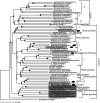New findings on evolution of metal homeostasis genes: evidence from comparative genome analysis of bacteria and archaea
- PMID: 16269744
- PMCID: PMC1287752
- DOI: 10.1128/AEM.71.11.7083-7091.2005
New findings on evolution of metal homeostasis genes: evidence from comparative genome analysis of bacteria and archaea
Abstract
In order to examine the natural history of metal homeostasis genes in prokaryotes, open reading frames with homology to characterized P(IB)-type ATPases from the genomes of 188 bacteria and 22 archaea were investigated. Major findings were as follows. First, a high diversity in N-terminal metal binding motifs was observed. These motifs were distributed throughout bacterial and archaeal lineages, suggesting multiple loss and acquisition events. Second, the CopA locus separated into two distinct phylogenetic clusters, CopA1, which contained ATPases with documented Cu(I) influx activity, and CopA2, which contained both efflux and influx transporters and spanned the entire diversity of the bacterial domain, suggesting that CopA2 is the ancestral locus. Finally, phylogentic incongruences between 16S rRNA and P(IB)-type ATPase gene trees identified at least 14 instances of lateral gene transfer (LGT) that had occurred among diverse microbes. Results from bootstrapped supported nodes indicated that (i) a majority of the transfers occurred among proteobacteria, most likely due to the phylogenetic relatedness of these organisms, and (ii) gram-positive bacteria with low moles percent G+C were often involved in instances of LGT. These results, together with our earlier work on the occurrence of LGT in subsurface bacteria (J. M. Coombs and T. Barkay, Appl. Environ. Microbiol. 70:1698-1707, 2004), indicate that LGT has had a minor role in the evolution of P(IB)-type ATPases, unlike other genes that specify survival in metal-stressed environments. This study demonstrates how examination of a specific locus across microbial genomes can contribute to the understanding of phenotypes that are critical to the interactions of microbes with their environment.
Figures




Similar articles
-
The p-type ATPase superfamily.J Mol Microbiol Biotechnol. 2010;19(1-2):5-104. doi: 10.1159/000319588. Epub 2010 Oct 20. J Mol Microbiol Biotechnol. 2010. PMID: 20962537 Review.
-
Retroids in archaea: phylogeny and lateral origins.Mol Biol Evol. 2003 Jul;20(7):1134-42. doi: 10.1093/molbev/msg135. Epub 2003 May 30. Mol Biol Evol. 2003. PMID: 12777534
-
STAND, a class of P-loop NTPases including animal and plant regulators of programmed cell death: multiple, complex domain architectures, unusual phyletic patterns, and evolution by horizontal gene transfer.J Mol Biol. 2004 Oct 8;343(1):1-28. doi: 10.1016/j.jmb.2004.08.023. J Mol Biol. 2004. PMID: 15381417 Review.
-
Genomes in flux: the evolution of archaeal and proteobacterial gene content.Genome Res. 2002 Jan;12(1):17-25. doi: 10.1101/gr.176501. Genome Res. 2002. PMID: 11779827
-
Evolution of glutamate dehydrogenase genes: evidence for lateral gene transfer within and between prokaryotes and eukaryotes.BMC Evol Biol. 2003 Jun 23;3:14. doi: 10.1186/1471-2148-3-14. Epub 2003 Jun 23. BMC Evol Biol. 2003. PMID: 12820901 Free PMC article.
Cited by
-
Bioavailability of heavy metals in soil: impact on microbial biodegradation of organic compounds and possible improvement strategies.Int J Mol Sci. 2013 May 15;14(5):10197-228. doi: 10.3390/ijms140510197. Int J Mol Sci. 2013. PMID: 23676353 Free PMC article. Review.
-
Five copper homeostasis gene clusters encode the Cu-efflux resistome of the highly copper-tolerant Methylorubrum extorquens AM1.PeerJ. 2023 Feb 20;11:e14925. doi: 10.7717/peerj.14925. eCollection 2023. PeerJ. 2023. PMID: 36846457 Free PMC article.
-
Comparative genomic analyses of copper transporters and cuproproteomes reveal evolutionary dynamics of copper utilization and its link to oxygen.PLoS One. 2008 Jan 2;3(1):e1378. doi: 10.1371/journal.pone.0001378. PLoS One. 2008. PMID: 18167539 Free PMC article.
-
Resistance of Permafrost and Modern Acinetobacter lwoffii Strains to Heavy Metals and Arsenic Revealed by Genome Analysis.Biomed Res Int. 2016;2016:3970831. doi: 10.1155/2016/3970831. Epub 2016 Oct 4. Biomed Res Int. 2016. PMID: 27795957 Free PMC article.
-
Omics technology draws a comprehensive heavy metal resistance strategy in bacteria.World J Microbiol Biotechnol. 2024 May 6;40(6):193. doi: 10.1007/s11274-024-04005-y. World J Microbiol Biotechnol. 2024. PMID: 38709343 Review.
References
-
- Axelsen, K. B., and M. G. Palmgren. 1998. Evolution of substrate specificities in the P-type ATPase superfamily. J. Mol. Evol. 46:84-101. - PubMed
-
- Bal, N., E. Mintz, F. Guillain, and P. Catty. 2001. A possible regulatory role for the metal-binding domain of CadA, the Listeria monocytogenes Cd2+-ATPase. FEBS Lett. 506:249-252. - PubMed
-
- Beard, S. J., R. Hashim, J. Membrillo-Hernandez, M. N. Hughes, and R. K. Poole. 1997. Zinc(II) tolerance in Escherichia coli K-12: evidence that the zntA gene (o732) encodes a cation transport ATPase. Mol. Microbiol. 25:883-891. - PubMed
Publication types
MeSH terms
Substances
LinkOut - more resources
Full Text Sources

